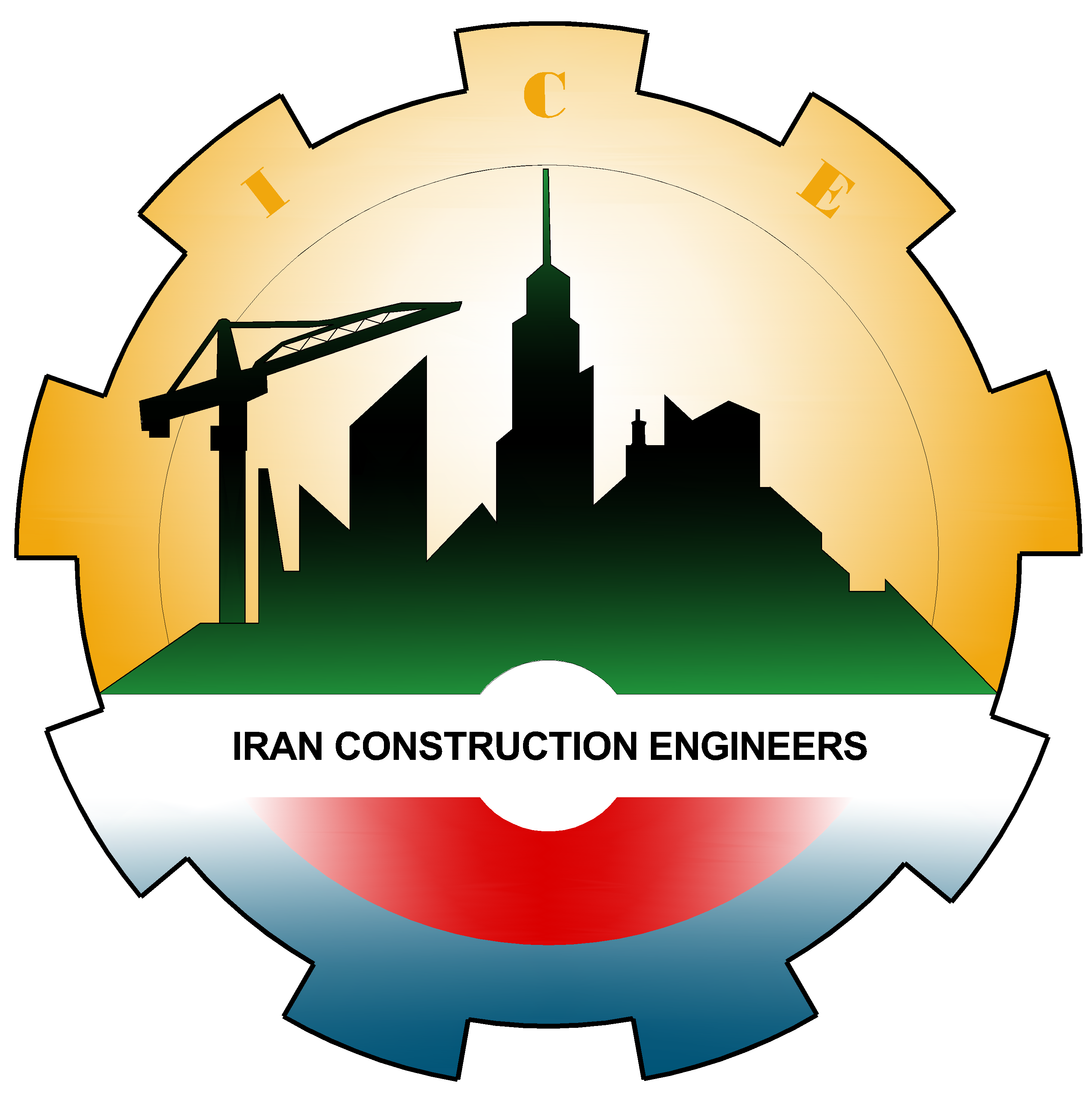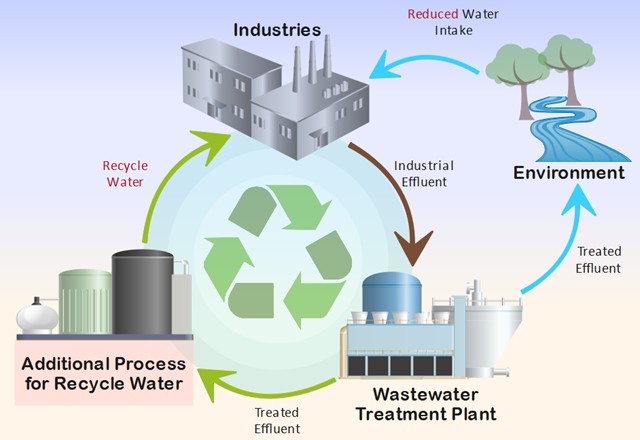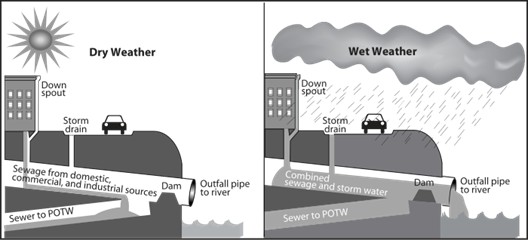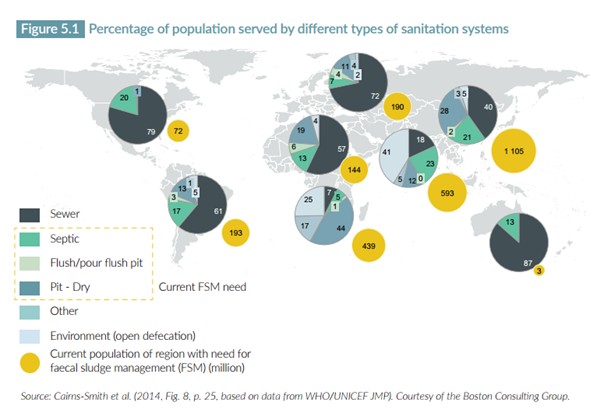
Civil Engineering Team
A leader in the design and implementation of the latest and the most innovative engineering methods



Sewage and Sewerage
Sewage (or domestic sewage, domestic wastewater, municipal wastewater) is a type of wastewater that is produced by a community of people. It is typically transported through a sewer system. Sewage consists of wastewater discharged from residences and from commercial, institutional and public facilities that exist in the locality.
Sub-types of sewage are:
Greywater (from sinks, bathtubs, showers, dishwashers, and clothes washers)
Blackwater (the water used to flush toilets, combined with the human waste that it flushes away).
The main parameters in sewage that are measured to assess the sewage strength or quality as well as treatment options include: solids, indicators of organic matter, nitrogen, phosphorus, and indicators of fecal contamination.
Sewerage (or sewage system) is the infrastructure that conveys sewage or surface runoff (stormwater, meltwater, rainwater) using sewers. It encompasses components such as receiving drains, manholes, pumping stations, storm overflows, and screening chambers of the combined sewer or sanitary sewer.
Sewerage ends at the entry to a sewage treatment plant or at the point of discharge into the environment. It is the system of pipes, chambers, manholes or inspection chamber, etc. that conveys the sewage or storm water.



Sewergae System
The main part of such a system is made up of large pipes (i.e. the sewers, or "sanitary sewers") that convey the sewage from the point of production to the point of treatment or discharge.
Types of sanitary sewer systems that all usually are gravity sewers include:
Sanitary sewers not relying solely on gravity include:


Valuable Resources in Recycling
Biogas Production: Sewage sludge can be anaerobically digested to produce biogas, a renewable energy source that can be used for heating, electricity, or as a vehicle fuel.
Fertilizers: Treated sewage sludge, also known as biosolids, can be processed and used as fertilizer in agriculture. It is rich in nutrients like nitrogen and phosphorus, which are essential for plant growth.
Water Reuse: Treated wastewater can be reused for non-potable applications, such as irrigation, industrial processes, and even replenishing groundwater supplies. This conserves freshwater resources.
Nutrient Recovery: Advanced treatment processes can recover valuable nutrients like phosphorus and nitrogen from sewage, which can then be used to create fertilizers or other products.
Bioplastics: Organic materials in sewage can be processed to produce biodegradable plastics, offering a sustainable alternative to traditional plastics.
Energy Generation: Sewage treatment plants can generate energy from biogas, reducing their reliance on external energy sources and even contributing to the grid.
Microalgae Cultivation: Wastewater can be used to cultivate microalgae, which can be processed into biofuels, animal feed, or even nutritional supplements.
Methods for Reusing Wastes
Chemical Recycling: This process breaks down plastic polymers into their constituent monomers, which can then be repurposed to create new plastic materials. It offers a sustainable solution for managing plastic waste.
Biodegradable Plastics: These plastics are designed to break down into harmless substances, reducing long-term environmental impact. They can be used in packaging and other applications, promoting a circular economy.
Waste-to-Energy (WTE): WTE technologies convert non-recyclable waste into energy through processes like incineration or anaerobic digestion. This reduces landfill waste and generates renewable energy2.
Advanced Sorting Technologies: Innovations in sorting technologies, including AI and robotics, improve the efficiency of recycling facilities by accurately separating different materials.
Closed-Loop Systems: These systems aim to keep materials in use for as long as possible by redesigning products for recyclability, remanufacturing, and developing closed-loop supply chains.
Bioconversion: This method uses biological processes to convert organic waste into valuable products like biofuels, compost, and biogas.
Digital Platforms for Waste Management: These platforms use data analytics and technology to optimize waste collection, sorting, and disposal processes, making waste management more efficient
New Innovations
There have been several innovative methods developed recently for handling sewage and wastewater management. Here are some of the most promising ones:
Membrane Bioreactors (MBRs): These systems combine conventional biological treatment with membrane filtration to remove contaminants from wastewater. They are highly effective in producing high-quality effluent suitable for reuse.
Advanced Oxidation Processes (AOPs): These processes use oxidants like ozone, hydrogen peroxide, and UV light to break down persistent organic pollutants in wastewater, making it safer for discharge or reuse.
Water Reuse and Recycling: Treating wastewater to a level where it can be reused for non-potable purposes, such as irrigation, industrial processes, or toilet flushing, helps conserve freshwater resources.
Artificial Intelligence (AI) and Machine Learning (ML): AI and ML are being used to optimize wastewater treatment processes, predict system failures, and monitor water quality in real-time. This helps improve efficiency and reduce operational costs2.Nanotechnology: Nanofiltration and ultrafiltration membranes are being used to achieve higher levels of water purity with lower energy consumption. These technologies are particularly useful in removing heavy metals and other contaminants.
Green Infrastructure: This approach uses natural systems, such as wetlands and green roofs, to manage stormwater and treat wastewater. It helps reduce the load on traditional sewage systems and promotes environmental sustainability.
Anaerobic Digestion: This process breaks down organic matter in sewage sludge to produce biogas, which can be used as a renewable energy source. It also reduces the volume of sludge that needs to be disposed of.
These new methods are transforming the wastewater treatment landscape, making it more efficient, sustainable, and environmentally friendly
Sanitation Type

Sewage and Sewerage
Sewage (or domestic sewage, domestic wastewater, municipal wastewater) is a type of wastewater that is produced by a community of people. It is typically transported through a sewer system. Sewage consists of wastewater discharged from residences and from commercial, institutional and public facilities that exist in the locality.
Sub-types of sewage are:
Greywater (from sinks, bathtubs, showers, dishwashers, and clothes washers)
Blackwater (the water used to flush toilets, combined with the human waste that it flushes away).
The main parameters in sewage that are measured to assess the sewage strength or quality as well as treatment options include: solids, indicators of organic matter, nitrogen, phosphorus, and indicators of fecal contamination.
Sewerage (or sewage system) is the infrastructure that conveys sewage or surface runoff (stormwater, meltwater, rainwater) using sewers. It encompasses components such as receiving drains, manholes, pumping stations, storm overflows, and screening chambers of the combined sewer or sanitary sewer.
Sewerage ends at the entry to a sewage treatment plant or at the point of discharge into the environment. It is the system of pipes, chambers, manholes or inspection chamber, etc. that conveys the sewage or storm water.



Sewergae System
The main part of such a system is made up of large pipes (i.e. the sewers, or "sanitary sewers") that convey the sewage from the point of production to the point of treatment or discharge.
Types of sanitary sewer systems that all usually are gravity sewers include:
Sanitary sewers not relying solely on gravity include:


Valuable Resources in Recycling
Biogas Production: Sewage sludge can be anaerobically digested to produce biogas, a renewable energy source that can be used for heating, electricity, or as a vehicle fuel.
Fertilizers: Treated sewage sludge, also known as biosolids, can be processed and used as fertilizer in agriculture. It is rich in nutrients like nitrogen and phosphorus, which are essential for plant growth.
Water Reuse: Treated wastewater can be reused for non-potable applications, such as irrigation, industrial processes, and even replenishing groundwater supplies. This conserves freshwater resources.
Nutrient Recovery: Advanced treatment processes can recover valuable nutrients like phosphorus and nitrogen from sewage, which can then be used to create fertilizers or other products.
Bioplastics: Organic materials in sewage can be processed to produce biodegradable plastics, offering a sustainable alternative to traditional plastics.
Energy Generation: Sewage treatment plants can generate energy from biogas, reducing their reliance on external energy sources and even contributing to the grid.
Microalgae Cultivation: Wastewater can be used to cultivate microalgae, which can be processed into biofuels, animal feed, or even nutritional supplements.
Methods for Reusing Wastes
Chemical Recycling: This process breaks down plastic polymers into their constituent monomers, which can then be repurposed to create new plastic materials. It offers a sustainable solution for managing plastic waste.
Biodegradable Plastics: These plastics are designed to break down into harmless substances, reducing long-term environmental impact. They can be used in packaging and other applications, promoting a circular economy.
Waste-to-Energy (WTE): WTE technologies convert non-recyclable waste into energy through processes like incineration or anaerobic digestion. This reduces landfill waste and generates renewable energy2.
Advanced Sorting Technologies: Innovations in sorting technologies, including AI and robotics, improve the efficiency of recycling facilities by accurately separating different materials.
Closed-Loop Systems: These systems aim to keep materials in use for as long as possible by redesigning products for recyclability, remanufacturing, and developing closed-loop supply chains.
Bioconversion: This method uses biological processes to convert organic waste into valuable products like biofuels, compost, and biogas.
Digital Platforms for Waste Management: These platforms use data analytics and technology to optimize waste collection, sorting, and disposal processes, making waste management more efficient
New Innovations
There have been several innovative methods developed recently for handling sewage and wastewater management. Here are some of the most promising ones:
Membrane Bioreactors (MBRs): These systems combine conventional biological treatment with membrane filtration to remove contaminants from wastewater. They are highly effective in producing high-quality effluent suitable for reuse.
Advanced Oxidation Processes (AOPs): These processes use oxidants like ozone, hydrogen peroxide, and UV light to break down persistent organic pollutants in wastewater, making it safer for discharge or reuse.
Water Reuse and Recycling: Treating wastewater to a level where it can be reused for non-potable purposes, such as irrigation, industrial processes, or toilet flushing, helps conserve freshwater resources.
Artificial Intelligence (AI) and Machine Learning (ML): AI and ML are being used to optimize wastewater treatment processes, predict system failures, and monitor water quality in real-time. This helps improve efficiency and reduce operational costs2.Nanotechnology: Nanofiltration and ultrafiltration membranes are being used to achieve higher levels of water purity with lower energy consumption. These technologies are particularly useful in removing heavy metals and other contaminants.
Green Infrastructure: This approach uses natural systems, such as wetlands and green roofs, to manage stormwater and treat wastewater. It helps reduce the load on traditional sewage systems and promotes environmental sustainability.
Anaerobic Digestion: This process breaks down organic matter in sewage sludge to produce biogas, which can be used as a renewable energy source. It also reduces the volume of sludge that needs to be disposed of.
These new methods are transforming the wastewater treatment landscape, making it more efficient, sustainable, and environmentally friendly
Sanitation Type

Sewage and Sewerage
Sewage (or domestic sewage, domestic wastewater, municipal wastewater) is a type of wastewater that is produced by a community of people. It is typically transported through a sewer system. Sewage consists of wastewater discharged from residences and from commercial, institutional and public facilities that exist in the locality.
Sub-types of sewage are:
Greywater (from sinks, bathtubs, showers, dishwashers, and clothes washers)
Blackwater (the water used to flush toilets, combined with the human waste that it flushes away).
The main parameters in sewage that are measured to assess the sewage strength or quality as well as treatment options include: solids, indicators of organic matter, nitrogen, phosphorus, and indicators of fecal contamination.
Sewerage (or sewage system) is the infrastructure that conveys sewage or surface runoff (stormwater, meltwater, rainwater) using sewers. It encompasses components such as receiving drains, manholes, pumping stations, storm overflows, and screening chambers of the combined sewer or sanitary sewer.
Sewerage ends at the entry to a sewage treatment plant or at the point of discharge into the environment. It is the system of pipes, chambers, manholes or inspection chamber, etc. that conveys the sewage or storm water.



Sewergae System
The main part of such a system is made up of large pipes (i.e. the sewers, or "sanitary sewers") that convey the sewage from the point of production to the point of treatment or discharge.
Types of sanitary sewer systems that all usually are gravity sewers include:
Sanitary sewers not relying solely on gravity include:


Valuable Resources in Recycling
Biogas Production: Sewage sludge can be anaerobically digested to produce biogas, a renewable energy source that can be used for heating, electricity, or as a vehicle fuel.
Fertilizers: Treated sewage sludge, also known as biosolids, can be processed and used as fertilizer in agriculture. It is rich in nutrients like nitrogen and phosphorus, which are essential for plant growth.
Water Reuse: Treated wastewater can be reused for non-potable applications, such as irrigation, industrial processes, and even replenishing groundwater supplies. This conserves freshwater resources.
Nutrient Recovery: Advanced treatment processes can recover valuable nutrients like phosphorus and nitrogen from sewage, which can then be used to create fertilizers or other products.
Bioplastics: Organic materials in sewage can be processed to produce biodegradable plastics, offering a sustainable alternative to traditional plastics.
Energy Generation: Sewage treatment plants can generate energy from biogas, reducing their reliance on external energy sources and even contributing to the grid.
Microalgae Cultivation: Wastewater can be used to cultivate microalgae, which can be processed into biofuels, animal feed, or even nutritional supplements.
Methods for Reusing Wastes
Chemical Recycling: This process breaks down plastic polymers into their constituent monomers, which can then be repurposed to create new plastic materials. It offers a sustainable solution for managing plastic waste.
Biodegradable Plastics: These plastics are designed to break down into harmless substances, reducing long-term environmental impact. They can be used in packaging and other applications, promoting a circular economy.
Waste-to-Energy (WTE): WTE technologies convert non-recyclable waste into energy through processes like incineration or anaerobic digestion. This reduces landfill waste and generates renewable energy2.
Advanced Sorting Technologies: Innovations in sorting technologies, including AI and robotics, improve the efficiency of recycling facilities by accurately separating different materials.
Closed-Loop Systems: These systems aim to keep materials in use for as long as possible by redesigning products for recyclability, remanufacturing, and developing closed-loop supply chains.
Bioconversion: This method uses biological processes to convert organic waste into valuable products like biofuels, compost, and biogas.
Digital Platforms for Waste Management: These platforms use data analytics and technology to optimize waste collection, sorting, and disposal processes, making waste management more efficient
New Innovations
There have been several innovative methods developed recently for handling sewage and wastewater management. Here are some of the most promising ones:
Membrane Bioreactors (MBRs): These systems combine conventional biological treatment with membrane filtration to remove contaminants from wastewater. They are highly effective in producing high-quality effluent suitable for reuse.
Advanced Oxidation Processes (AOPs): These processes use oxidants like ozone, hydrogen peroxide, and UV light to break down persistent organic pollutants in wastewater, making it safer for discharge or reuse.
Water Reuse and Recycling: Treating wastewater to a level where it can be reused for non-potable purposes, such as irrigation, industrial processes, or toilet flushing, helps conserve freshwater resources.
Artificial Intelligence (AI) and Machine Learning (ML): AI and ML are being used to optimize wastewater treatment processes, predict system failures, and monitor water quality in real-time. This helps improve efficiency and reduce operational costs2.Nanotechnology: Nanofiltration and ultrafiltration membranes are being used to achieve higher levels of water purity with lower energy consumption. These technologies are particularly useful in removing heavy metals and other contaminants.
Green Infrastructure: This approach uses natural systems, such as wetlands and green roofs, to manage stormwater and treat wastewater. It helps reduce the load on traditional sewage systems and promotes environmental sustainability.
Anaerobic Digestion: This process breaks down organic matter in sewage sludge to produce biogas, which can be used as a renewable energy source. It also reduces the volume of sludge that needs to be disposed of.
These new methods are transforming the wastewater treatment landscape, making it more efficient, sustainable, and environmentally friendly
Sanitation Type
